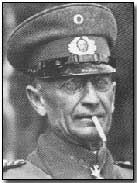Battles - The Battle of Romani, 1916
 The Battle of Romani heralded the second notable attempt by Turk forces to seize
control of the critical Suez Canal, then in British hands, in August 1916.
The Battle of Romani heralded the second notable attempt by Turk forces to seize
control of the critical Suez Canal, then in British hands, in August 1916.
An earlier attack in early February 1915 had been handily repulsed by British forces. For the remainder of 1915 both Turkish and British forces had been committed to the Gallipoli campaign, although the ever-present threat to the canal led the British to commit a wide presence to ensure its defence.
As 1916 dawned the British force, led by Sir Archibald Murray and which included Australian and New Zealand troops, began to move left of the canal towards Palestine, the intention being to establish a fresh defensive line some 160 kilometres away. Progress was slowed however by the laying of an accompanying pipeline and road and rail link.
Meanwhile the Turks, under German commander Kress von Kressenstein, were mooting a fresh attack upon the canal, originally planned for the autumn but pulled forward to the summer following the collapse of Serbia and the consequent influx of German reinforcements to Turkey. Kressenstein's intention was to occupy the canal's left bank and to thereafter use heavy artillery to impede Allied shipping.
Thus a combined force of approximately 16,000 Turk and Arab forces were grouped along the Sinai-Palestine border by June 1916. The attack was delayed however pending the arrival of machine guns, heavy artillery and anti-aircraft forces.
In response Murray was able to deploy his main force of two and a half infantry divisions 30 km east of the canal in fortified positions, to the west of the railhead town of Romani. Kressenstein's advance was itself dictated by the availability of water supplies, with all but the depots in the northern coastal area of the Sinai Desert having been earlier destroyed by the British.
 By
mid-July Kressenstein had established his force just outside of Romani,
slightly outnumbered by the British. An attack was not immediately
launched however, again pending the arrival of heavy artillery.
By
mid-July Kressenstein had established his force just outside of Romani,
slightly outnumbered by the British. An attack was not immediately
launched however, again pending the arrival of heavy artillery.
In the event Kressenstein made his move on the night of 3/4 August with an attack on British lines south of Romani.
Despite initially securing part possession of the town in the face of minimal British opposition, further progress proved hard to come by and repeated British counterattacks (boosted by the rapid arrival of reinforcements) succeeded in not only reversing earlier Turkish gains but in pushing Kressenstein's force into retreat, the latter spurred by a shortage of water.
Having sustained 4,000 casualties (and as many more taken prisoner) Kressenstein led his force back 100 km to El Arish where the Turkish authorities pronounced the attack a victory. In reality however the failure of Kressenstein's assault removed any further direct threat to the Suez Canal. British casualties numbered approximately 1,100.
The British force thereafter continued its move eastwards, itself arriving at and securing El Arish in December 1916, and thus successfully clearing the whole of the Sinai Peninsula of Turkish forces.
Click here to view a map of pre-war Palestine and Mesopotamia.
Photographs courtesy of Photos of the Great War website
"Harry Tate" was the nickname given by British pilots to the R.E.8 aircraft
- Did you know?
